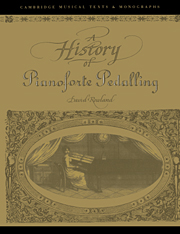Book contents
- Frontmatter
- Contents
- Acknowledgements
- List of abbreviations
- Introduction
- PART I The instruments
- 1 The transition from the harpsichord and clavichord to the piano
- 2 Stops, levers and pedals
- PART II Pedalling and the early pianists
- PART III Pedalling after c.1800
- APPENDIX: Chapters on pedalling from piano tutors
- Notes
- Select bibliography
- Index
2 - Stops, levers and pedals
Published online by Cambridge University Press: 16 November 2009
- Frontmatter
- Contents
- Acknowledgements
- List of abbreviations
- Introduction
- PART I The instruments
- 1 The transition from the harpsichord and clavichord to the piano
- 2 Stops, levers and pedals
- PART II Pedalling and the early pianists
- PART III Pedalling after c.1800
- APPENDIX: Chapters on pedalling from piano tutors
- Notes
- Select bibliography
- Index
Summary
The harpsichord
Because of the way in which keyboard instruments were used interchangeably in the eighteenth century it is not unreasonable to assume that attitudes to stops, levers and pedals on one instrument were transferred to another. Certainly there were national trends in instrument making common to both the harpsichord and the piano: countries, for example, which tended to use knee levers on harpsichords also tended to use them on pianos, and countries where the number of devices used on harpsichords was comparatively large also tended to see extravagant numbers of pedals or levers on pianos. It is therefore appropriate to consider briefly the history of stops, levers and pedals on the harpsichord before pursuing their use on the piano.
Early developments
In 1713 François Couperin observed that ‘the harpsichord is perfect as to its range, and brilliant in its own right; but since it is impossible to increase or diminish the sound I shall always be grateful to those who, by infinite art supported by good taste, succeed in making the instrument capable of expression’. Most of the devices that were added to the instrument at various stages of its history were attempts to rectify this defect.
- Type
- Chapter
- Information
- A History of Pianoforte Pedalling , pp. 14 - 26Publisher: Cambridge University PressPrint publication year: 1993



